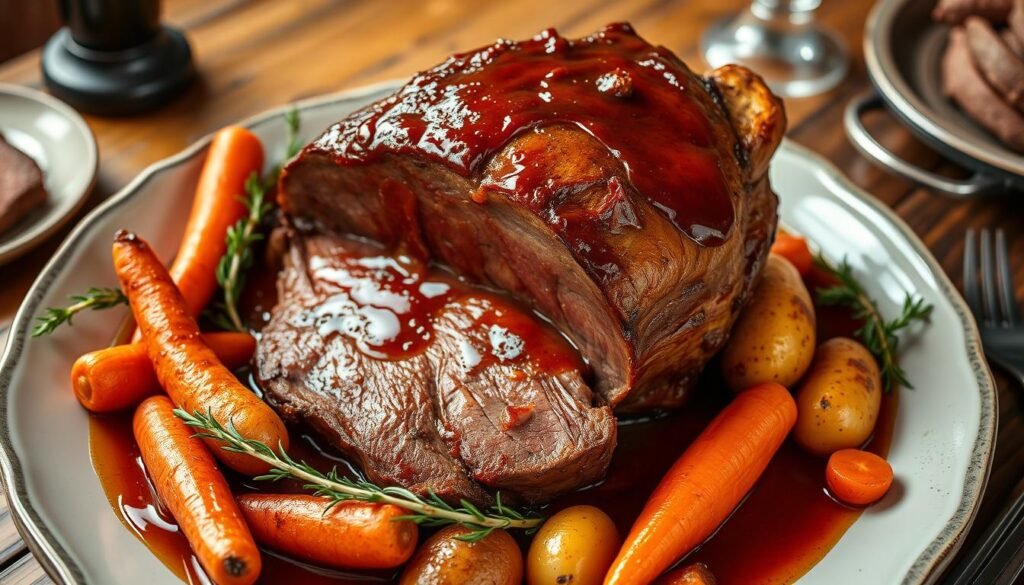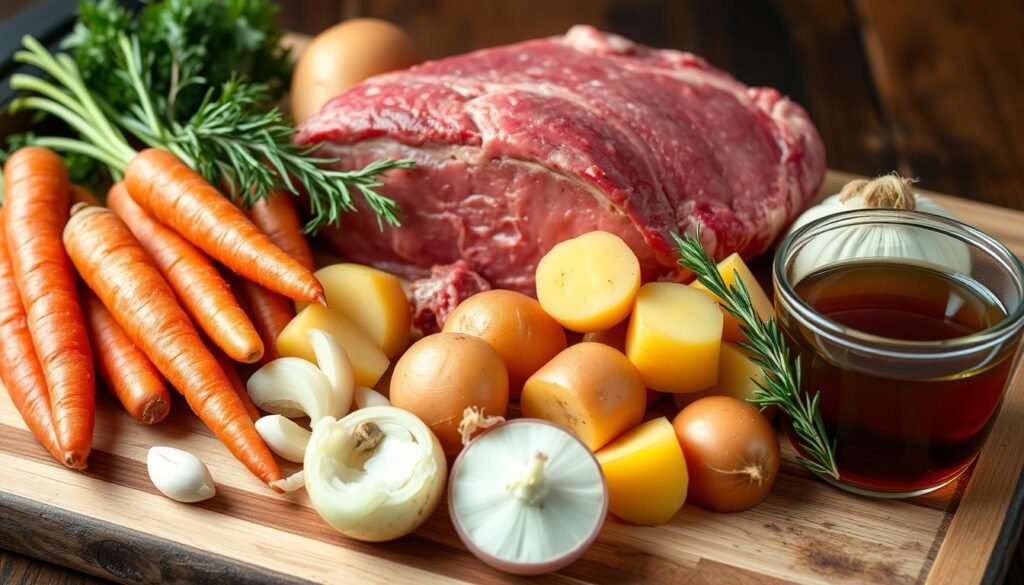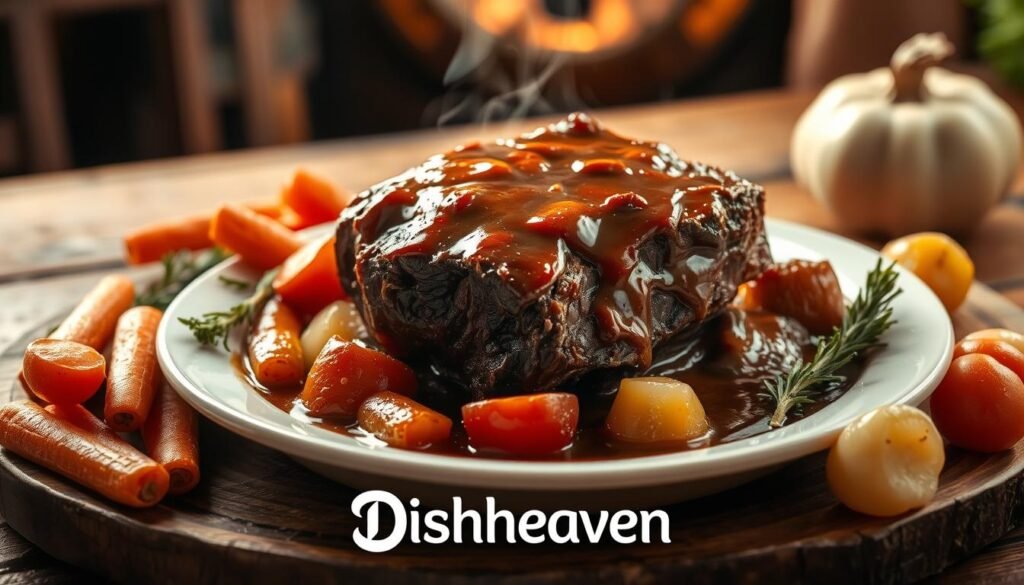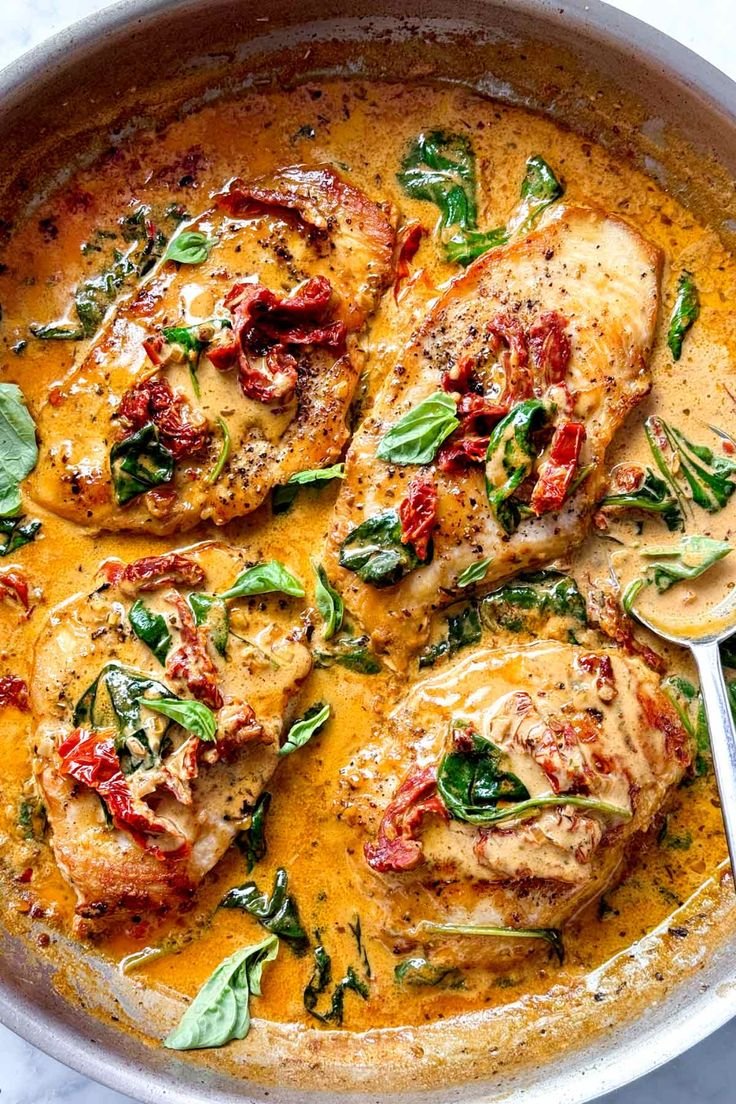The Best Fluffy Pancakes recipe you will fall in love with. Full of tips and tricks to help you make the best pancakes.
Classic Pot Roast: A Tender & Juicy Sunday Dinner
Sundays are perfect for family dinners, especially with a classic pot roast. This dish is loved for its tender beef and rich gravy. The smell of the roast and the sound of vegetables sizzling make the kitchen cozy.
The secret to a great pot roast is slow cooking. This method makes the meat soft and tender. It’s a dish that feels like home, with flavors of beef, herbs, and veggies blending together.

Key Takeaways
- Classic pot roast is a beloved Sunday dinner staple known for its tender, slow-cooked beef and rich, flavorful gravy.
- The low and slow cooking method is essential for breaking down tough connective tissues, resulting in a melt-in-your-mouth texture.
- The aroma and flavors of the roast, vegetables, and mashed potatoes create a comforting and satisfying family meal.
- Pot roast is a versatile dish that can be customized with various cuts of beef and a range of aromatic vegetables and seasonings.
- Achieving the perfect pot roast requires attention to temperature control, moisture management, and proper resting and serving techniques.
What Makes the Perfect Pot Roast
Its an art that needs a deep understanding of tender meat and the right tools. The secret to tender meat is breaking down collagen, a tough protein in meat. This makes the meat tender if cooked right.
The Science Behind Tender Meat
The secret to tender pot roast is slow cooking. This breaks down collagen into gelatin, making the meat soft and tasty. Cooking it low and slow is key
Essential Equipment and Tools
The right tools are crucial for a perfect pot roast. A heavy-duty Dutch oven is best because it keeps moisture in and heat even. The Dutch oven works great on the stovetop or in the oven, making it perfect for this dish.
Choosing the Right Cut of Beef
Not all beef is good for pot roast. The chuck roast is the best choice because it’s marbled and tough. Its fat and connective tissues melt during cooking, making the meat tender and juicy.
The History and Evolution of Sunday Pot Roast Dinners
The Sunday pot roast dinner is a beloved part of American culture. It’s a tradition that brings families together. It started with early settlers using slow cooking to make tough meat tender.
Over time, the Sunday pot roast became more than just food. It became a special time for families to share. Across the United States, this meal shows the diversity of American cuisine and traditions.
Today, the way we make and enjoy Sunday pot roast has changed. But its core remains the same. It’s about family and community coming together. Whether with root vegetables, herbs, or gravy, it’s a cherished tradition in American cuisine.
“The Sunday pot roast dinner is more than just a meal; it’s a shared experience that connects us to our roots, our heritage, and the enduring traditions that have shaped the fabric of American life.”
| Region | Signature Variations | Cultural Significance |
|---|---|---|
| Northeast | Hearty, slow-cooked pot roast with potatoes, carrots, and onions | A beloved Sunday tradition passed down through generations, often served with crusty bread and a side of creamy mashed potatoes |
| Midwest | Pot roast braised in a mixture of beef broth, red wine, and aromatic vegetables | A comforting and warming meal that brings families together, often accompanied by homemade noodles or dumplings |
| South | Tender pot roast seasoned with a blend of spices, served with collard greens and cornbread | A reflection of the region’s rich culinary heritage, blending African, European, and Native American influences |
Essential Ingredients
Making a perfect pot roast is a skill passed down through generations. It starts with a few key ingredients that work together to create a delicious, tender dish. From the meat to the seasonings, each part is crucial for a great pot roast.
Best Cuts of Meat for Pot Roast
The choice of beef is key for pot roast. Chuck roast and brisket are the top picks. These cuts are tough but become tender and juicy with slow cooking.
Aromatics and Seasonings
The base of a good pot roast comes from a mix of aromatics. Onions, carrots, and garlic add sweetness and depth. Rosemary and thyme bring earthy scents. A pinch of salt and pepper enhances the flavors.
Root Vegetables and Herbs
Root veggies and herbs are essential for a complete pot roast. Potatoes, carrots, and onions add texture and taste. A sprinkle of rosemary and thyme boosts the flavor even more.
| Ingredient | Purpose |
|---|---|
| Chuck Roast | Provides rich, tender texture when slow-cooked |
| Brisket | Another tough cut that becomes melt-in-your-mouth when braised |
| Onions, Carrots, Garlic | Create a flavorful aromatic base for the dish |
| Rosemary, Thyme | Lend earthy, fragrant notes to the overall seasoning |
| Potatoes, Carrots | Provide a hearty, textural accompaniment to the tender beef |

“The key to a perfect pot roast is in the patience and care you put into each step of the process. The end result is a dish that is truly greater than the sum of its parts.”
Step-by-Step Guide
Making the perfect pot roast is about mastering the cooking basics. From browning the meat to making a tasty braising liquid, each step is key. It turns tough beef into a tender, delicious dish. Let’s explore how to make the ultimate pot roast.
- Begin by browning the meat to keep flavors in. Sear the beef on all sides in a hot, oiled pan. This creates a beautiful caramelized crust.
- After browning, deglaze the pan. Pour in wine, broth, or water to get all the tasty browned bits from the bottom.
- Put the browned beef in a slow cooker or Dutch oven. Add your braising liquid, like beef broth or red wine. Also, add veggies like onions, carrots, and celery.
- Slow cooking makes the pot roast tender and juicy. Cover it and let it simmer for 3-4 hours. The meat should be fork-tender.
- Check the liquid level often. Add more braising liquid if needed to keep the meat covered.
By following these steps and mastering browning, deglazing, and slow cooking, you’ll make a pot roast fit for a Sunday dinner. Enjoy the rich flavors and tender texture that make this dish a comfort food classic.

Tips for Achieving Fork-Tender Results
To make a melt-in-your-mouth pot roast, you need to balance temperature, moisture, and resting techniques. Mastering these elements can take your Sunday dinner to the next level of tenderness and flavor.
Temperature Control Techniques
Low and slow cooking is key to making tough beef cuts tender. Keep your oven at 275°F (135°C) to break down connective tissues slowly. This makes the roast succulent and easy to fall apart. It’s important to use a meat thermometer to check the internal temperature. It should be between 195-205°F (91-96°C).
Moisture Management Methods
It’s crucial to keep the roast moist during long cooking times. Baste it with the flavorful cooking liquid often. If the pan starts to dry, add some broth or water. Covering the pot with a tight lid or foil helps keep moisture in and prevents evaporation.
Resting and Serving Guidelines
Once the roast is cooked to the right temperature, let it rest for 15-20 minutes before slicing. This resting time lets the juices spread evenly, making each bite moist and flavorful. When you’re ready to serve, slice the pot roast against the grain for the best texture. Don’t forget to spoon the rich cooking liquid over the top.
“Bring comfort to your table with this classic Pot Roast recipe! Try it today and share your delicious results with DishHeaven. Let’s create hearty meals that bring everyone together!”







